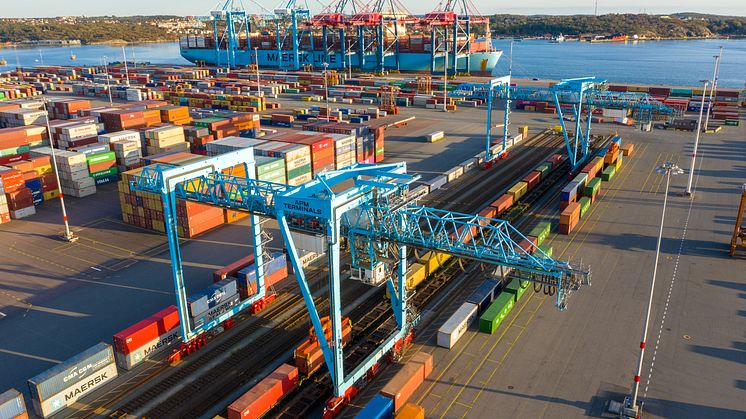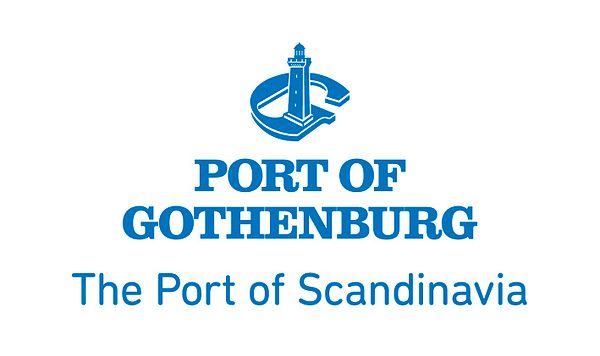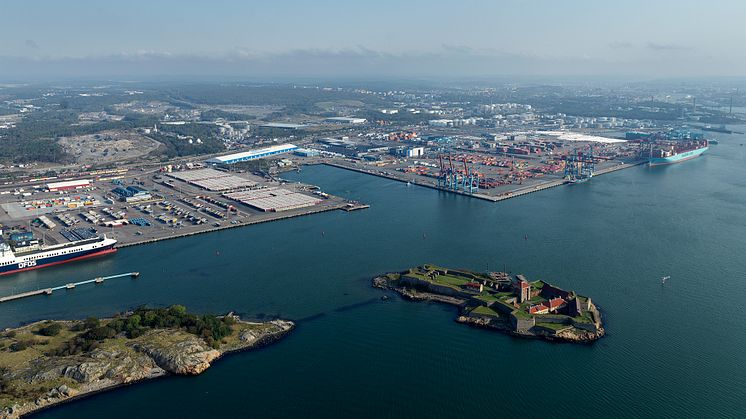
Press release -
Local storage aims to relieve the load on the Port of Gothenburg and cut emissions
At the Port of Gothenburg, collaboration is now being intensified with the port’s rail connected inland terminals. By offering local intermediate storage of import containers at inland terminals all over Sweden, the intention is to make additional optimisation possible in customers’ logistical solutions.
The ”Port of Gothenburg RAILPORT container storage initiative” was presented to customers earlier in September by The Gothenburg Port Authority and APM Terminals Gothenburg – together with many of the port’s inland terminals. The purpose is increasingly to move the intermediate storage of import containers from the port to inland terminals closer to the final destination of the goods all over Sweden.
If an import container from China has Eskilstuna as its final destination, for example, it’s an advantage if intermediate storage also takes place at the inland terminal in Eskilstuna. The owner of the products then has better accessibility to the goods when the time comes to collect them.
The conditions for this are in place, thanks to the port’s network of inland terminals all over the country that are connected to the rail network.
“The inland terminals have everything needed in terms of space, equipment, security and know-how to handle and warehouse container goods. The logic of this is crystal clear, and we’ve had a really good response from the market, now that we’ve further developed this concept together,” says Claes Sundmark, VP Sales and Marketing at the Gothenburg Port Authority.
The port’s expanding rail network, Railport Scandinavia, now has more than 30 inland terminals at locations all over Sweden, and in 2021 more container goods were transported via this system than ever before. There is also an increase in the proportion of rail transport operations at the port – more than 60% of the container goods that pass the quayside now take the train into or out of the port on the land side. These are levels that few other major international ports can match.
“Rail transport operations are reliable, efficient and environment-friendly, and the system has high capacity. The railway has also grown to become even stronger as a land-based transport option in recent times, partly due to increased diesel prices and the current shortage of truck drivers,” says Claes Sundmark.
“Robust plans in place”
The background to the initiative starting now is the continued strain on the logistics chain due to a number of external factors, the most wide-ranging of which are the consequences of Covid-19 and the Russian invasion of Ukraine. Together, they have resulted in, among other things, major restrictions and congestion in many of the biggest ports in the world.
But despite the global logistics problems, container volumes at the Port of Gothenburg are rising steadily – the latest report showed a 5% increase in the past six months. This is largely due to the fact that shipping companies and product owners are increasingly using the Port of Gothenburg for their transport requirements ahead of other ports in Sweden.
APM Terminals Gothenburg handles the vast majority of the containers at the Port of Gothenburg. The terminal is also connected directly to the rail network via the terminal’s railway harp.
“APM Terminals Gothenburg today handles 49 percent of the total Swedish container market and we continue to grow in a tough market. We are pleased with the development and have robust plans in place to meet the increased demand. As part of that, we need to optimize the yard and create space for efficient and smooth flows through the terminal," says Svante Altås Sr. Sales Executive at APM Terminals Gothenburg.
Topics
Fact file: Port of Gothenburg
The Port of Gothenburg is the largest port in Scandinavia. Around 30% of Swedish domestic and foreign trade passes through the Port of Gothenburg and over 50% of all container traffic. The port is a full-service port, and offers industry guaranteed, climate-smart access to the whole world. Direct services to key markets ensure highly efficient, sustainable, and reliable transport 24 hours a day, 365 days a year. The focus is firmly on sustainability, innovation, and digitalisation in a concerted effort to maintain the ongoing development of climate-efficient freight transport and calls by vessels. With over 30 rail shuttles offering daily departures, companies throughout Sweden and Norway have a direct, climate-neutral service to the Port of Gothenburg. The port handles energy products, vehicles, ro-ro units, containers and passengers. 22,000 people are employed at the port.
Follow us on:
Facebook
Instagram
LinkedIn
Twitter
www.portofgothenburg.com


